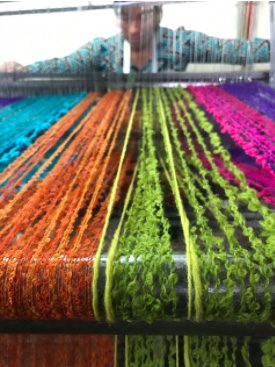IBD Suritex
Written by Gloria Gerngross, Sophia Kaady, Deepak Nainani, Isei Nakae, and Lyndsey Wilson
The sun was setting on the rural landscape, the grassy highlands of rural Peru, as Gregor’s truck bounced over unpaved, rocky roads, all five of our team members squished into the backseat as he sped to the new textile workshop before night fell. We had spent the day in a bus from Lima, winding our way through the Cordillera mountain range for 8 hours and ascending 14,000 feet to Huancayo, where our client was waiting to introduce us to the women who worked in the textile workshop, and the alpaca breeders who lived in the highlands.
We arrived at the construction site with just 20 minutes to spare before the horizon was swallowed by the darkness. Gregor’s eyes lit up as he waved his hands, pointing at empty space above the large foundation as though showing his blueprint for the new plant. Where we saw exposed rebar and hand-laid concrete bricks, he saw a room for the women’s children to play, a resting area for alpaqueros that came to have their fibers weighed, graded, and dyed, and a weaving room four times the size of their current plant’s. We left inspired by Gregor’s vision for growing his small social enterprise and energized to use our business skills to enable this dream to become a reality.
 The Project
The Project
Our team was hired by NESsT, an Oakland-based impact investing firm, to help its portfolio company, Suritex, increase its revenues by expanding sales of alpaca-blend textiles into the U.S. market. Though Suritex prides itself on its high-quality products created through technically sophisticated dying, weaving, and fiber-blending methods, it is their impact on the rural Lima region that is truly incredible. Suritex pays above-market prices for alpaca fibers, ensuring continued livelihoods of agricultural communities. They hire and train single women to operate machinery and manufacture textiles, creating jobs in communities struggling to develop economically. Our team met several women who worked in their factory, and their young children played while they fed colorful yarn into the large looming machines.
Prior to arriving in Lima, our team focused on understanding the U.S. alpaca-based goods market, sales channels, and our client’s capabilities to create designs and products that U.S. customers would be excited to buy. However, the disparate nature of the imported alpaca-based goods (textiles, clothing, and yarn) market made it difficult to collect any quantitative data, so our team relied on information collected by visiting local stores, and interviewing sales partners and customers.
This preliminary research led us to conclude that our client needed a re-brand, targeted marketing towards high-income, socially conscious customer segments, and to emphasize their strong social and environmental impact to differentiate themselves among hundreds of textile importers. We were excited to meet the client, visit the processing facilities, and better understand how we could make Suritex stand out among competitive exporters of similar products.
 The Focus Changes
The Focus Changes
Once in-country, we learned more about Suritex’s technically sophisticated and uniquely socially-conscious supply chain. Our meetings with the textile mill workers and the alpaqueros confirmed the importance of scaling Suritex’s efforts, and inspired and energized us to develop a sales and marketing strategy so that U.S. customers understand the impact that their Suritex purchase will have on the community.
It came as a surprise to our team to learn that our client had already hired a marketing consulting team, so we were no longer needed in the proposed re-brand! While our team had initially focused on creating branding and marketing strategy that would enable Suritex to successfully enter the US market, we had to do a 180° pivot and reframe our project. When our focus had to change, we spent hours whiteboarding and reframing the problem, ultimately pivoting to more of a sales and product strategy. Our focus turned then on researching the logistics of how to actually sell products in the US: who to sell to, how to sell them, and which products to sell.
 The Final Presentation
The Final Presentation
Our final presentation provided Suritex with tactical recommendations on how to begin selling products in the US, and how to modify their current product offerings to ensure U.S. customer interest in their products. We provided a thorough go-to-market guidebook that included sales on online platforms (such as Etsy or Amazon), hiring a fulfillment center and sales reps to manage buyer relationships, and which certifications and trade shows to pursue to access the right B2B customers. Our client, a technical and operations-focused career manufacturer, was very happy with the detailed recommendations. Our team left energized by the important work of Suritex, driven by the knowledge that our recommendations would enable Suritex to reach its goal of building more manufacturing facilities closer to workers’ communities, hiring and educating more workers, and ultimately developing these rural economies to support the sustainability of this artisan trade.



